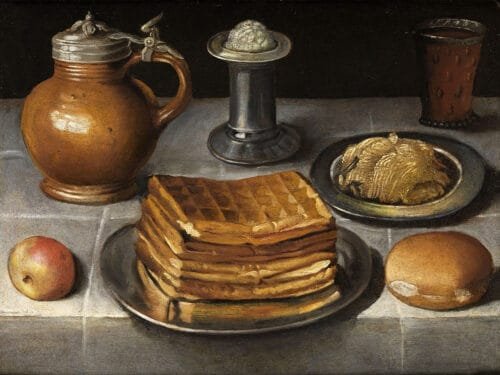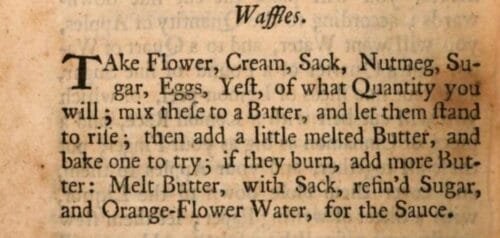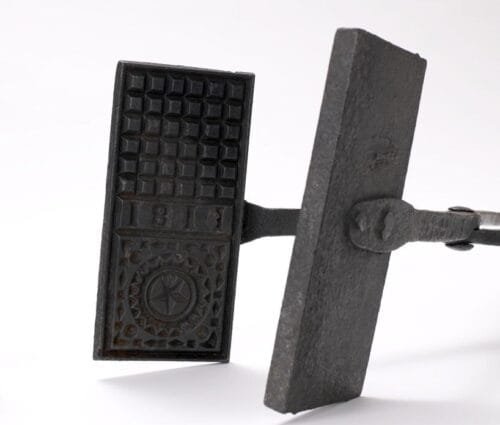A Brief History of Waffles

A Brief History of Waffles
Since waffles are closely associated with Lady Day and that’s just around the corner, I thought it would be fun to do a quick diving into the research rabbit hole, looking at the history of waffles!

Ancient History of Waffles
Waffles trace all the way back to ancient Greece where they were flat cakes called obleios, cooked between two hot metal plates, the earliest waffle irons. By the middle ages, these cakes, made form flour, milk or water, and sometimes eggs became known as wafers and continued in their popularity.
By the 13th century, the craftsmen started embellishing the metal cooking places with designs ranging from family crests, to landscapes to religious imagery rather than the classic grid pattern we know today. When crusaders returned with spices like cinnamon and ginger, these flavors made their way into wafer batter. So too did cream, honey, butter and leavening agents that resulted in thicker, doughier products that much more closely resembled the modern waffle.
Wafers were sold by street vendors in 14th century England. These waferers (or gaufriers as they were known in France) would gather at church doors on holy days to sell their wares in such numbers, chaos often ensued as they set up stalls to bake their wares fresh and sell them piping hot. France’s Charles IX went so far as to pass a law that waferers had to stand at least eight feet apart to sell their wares. (Early social distancing, anyone?)
Waffle Irons

Around the 15th century, for reasons largely unknown, Dutch waffle makers began using rectangular plates with the grid we associate with waffles today. At first, only the wealthiest homes had waffle irons, such delicacies were frequently left to professional kitchens. (An interesting side note, often times cheese graters were found in archeological dig that also found waffle irons, probably because many medieval waffle recipes were savory dishes that called for cheese.) When waffles were sweet, they were served as a dessert, not breakfast.
The waffle irons pictured below were meant to be used over an open flame. The long handles protected the cook from the flame and hot metal. Still cooking them was a temperamental process, remember no non-stick metals, no way to control the heat, and only experience to help guide the cook to know when they were done.

Waffle iron with crucifix imagery. Pingsjong GNU Free Documentation License, 
“Cast iron mold in the form of large hinged pliers closing with a ring, made up of 2 rectangular plates, one with a rim and the other flat. They are enhanced with hollow geometric patterns to print the dough after the cooking. ” BERNARDOT Claude-Henry Creative Commons Attribution-Share Alike 3.0 
Cast Iron Waffle Iron, Eichinger, Public Domain 
Round Waffle Iron. Karl Gruber, Creative Commons Attribution 3.0 Austria
Waffles in the New World
The Dutch introduced the first waffles to North America around 1620 although printed waffle recipes did not become available until the early to mid 1700’s. The modern spelling of waffle, with two f’s became established at that time as well probably due to the spelling of the recipe in Robert Smith’s important cookbook, Court Cookery, initially published in 1725(seen below).

Thomas Jefferson introduced the first long-handled waffle iron and ‘modern’ waffle recipes to the US. around 1790.
In Europe, regional waffle recipes (and accompaniments) proliferated. Germans favored coffee waffles, while the French used cloves, Spanish wine and lemon zest. A thick waffled covered in caramelized sugar became popular in Belgium.
Waffle Frolics
With the availability of recipes and waffle irons, by the mid to late 18th century up through the mid 19th century, ‘Waffle Frolics’ became a thing. Family and friends would be invited for a party where the main attraction was baking waffles, often with each person getting to bake their own. It could be a slow process, though and generally other foods were served as well and parlor games played while the waffles cooked.

Not surprisingly, household manuals began publishing instructions on how to host a waffle party. Invitations resembling waffles were often recommended, some elaborate pieces of stitching that resembled waffles and were scorched to the color of waffles with a hot iron. Recipe cards might be handed out and the process of waffle baking orchestrated by a Master of Ceremonies! (Honestly, that does sound like a rather fun sort of party to do even today! With an electric waffle iron of course!)
Historical Recipes
These are a few recipes which might have been used at the original waffle frolics:
To Fry Waffles, 1683
For each pound [one English pound, or 454 grams] of Wheat-flour take a pint [about a half a litre] of sweet Milk, a little tin bow, of melted Butter with 3 or 4 Eggs, a spoonful of Yeast well stirred together.”
—De Verstandige Kock (The Sensible Cook) [Netherlands, 1683?], Translated and Edited by Peter G. Rose [Syracuse University Press:Syracuse] 1989 (p. 76)
Waffles, 1849
Put two pints of rich milk into separate pans. Cut up and melt in one of them a quarter of a pound of butter, warming it slightly; then, when it is melted, stir it about, and set it away to cool. Beat eight eggs till very light, and mix them gradually into the other pan of milk, alternately with half a pound of flour. The mix it by degrees the milk that has the butter in it. Lastly, stir in a large table-spoonfull of strong fresh yeast. Cover the pan and set it near the fire to rise. When the batter is quite light, heat your waffle-iron, by putting it among the coals of a clear bright fire; grease the inside with butter tied in a rag, and then put in some batter. Shut the iron closely, and when the waffle is done on one side, turn the iron on the other. Take the cake out by slipping a knife underneath; and then heat and grease the iron for another waffle. Send them to table quite hot, four or six on a plage; having buttered them and strewed over each a mixture of powdered cinnamon, and white sugar. Or you may send the sugar and cinnamon in a little glass bowl.”
—Directions for Cookery in its Various Branches, Miss Leslie [Philadelphia, 1849]. (p. 359)
Mrs. B.’s Waffles, 1858
One quart of flour, and a teaspoonful of salt. One quart of sour milk, with two tablespoonfulls of butter melted in it. Five well-beated eggs. A Teaspoonful for more of saleratus [precursor of baking soda], enough to sweeten the milk. Baked in waffle irons. Some like one tea-cup full of sugar added.”
—Miss Beecher’s Domestic Receipt Book, Catharine E. Beecher [New York, 1858] (p. 96)
I’m so grateful for electric waffle irons! I can’t imagine trying to cook waffles over an open flame. I don’t have too many specialty gadgets in my kitchen, but my waffle maker is a must. Come by my kitchen later this week for our family favorite waffles!
References
https://janeausten.co.uk/blogs/snacks-and-sides/waffles-for-lady-day
http://www.foodtimeline.org/foodfaq2.html#waffles
https://www.thekitchn.com/from-wafers-to-cones-a-short-h-113627
https://www.mentalfloss.com/article/78997/wafel-wafers-belgian-breakfasts-brief-history-waffles
https://play.google.com/books/reader?id=O_AHAAAAQAAJ&pg=GBS.PP5





What fun! 🙂
Back in the day, before it closed, my father and I would go to our local Waffle House and order waffles with a side of crisp bacon. He has been gone several years now and every time I order a waffle, I think of him. Those were fond memories. He was a great guy and everyone loved him. Thanks for this post. It made me smile. Blessings, stay safe, and healthy.
We have a Waffle House here at the exit off I-78. I have an electric waffle iron appliance and used it often while my children were still living at with us. Lovely that you have those memories of your father, Jeanne.
Pingback:A Virtual Waffle Frolic ~ Random Bits of Fascination